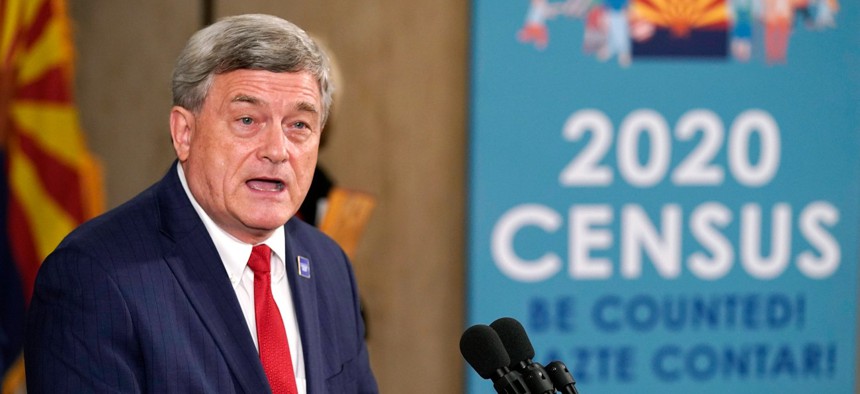
U.S. Census Director Steven Dillingham speaks as he joins Arizona Gov. Doug Ducey at a news conference to urge Arizonans to participate in the nation's once-a-decade census population count on Sept. 17 in Phoenix. Ross D. Franklin / AP
Decision to Shorten Census Schedule Came From Outside the Census Bureau, IG Says
That decision is risking an incomplete and inaccurate count.
The Census Bureau was not involved in a decision to cut short its time to collect and deliver results for its decennial count, a watchdog has found, once again warning the shortened schedule is risking an incomplete and inaccurate enumeration.
The Commerce Department inspector general could not identify who required the bureau to finish counting U.S. residents by the end of September and deliver data by the end of the year—rather than by the end of October 2020 and April 2021, respectively, as previously scheduled due to delays necessitated by the novel coronavirus pandemic—saying the direction likely came from either Commerce or the White House. Senior officials at the bureau, including Director Steven Dillingham, told the IG they did not know who ultimately made the decision to change the timetables for the census.
Commerce, the Census Bureau’s parent department, criticized the IG for highlighting what it deemed an irrelevant detail, noting it had to comply with a statutory mandate to deliver reapportionment data by the end of the year. President Trump and Commerce Secretary Wilbur Ross had previously announced support for delaying the enumeration and data delivery and asked Congress for permission to do so, but so far only the House has passed legislation to that end and the Trump administration has backed away from its request.
“The OIG report’s curious focus on who made the decision to comply with the statutory deadline misses the mark,” Commerce said in a statement. “The statutory deadline is the law, and Census Bureau and Commerce Department employees—like all federal employees, including those in the Office of Inspector General—took an oath to comply with the law. It is dangerous to suggest that compliance with the law is optional in the face of operational risk, and the department strongly rejects such a suggestion.”
In mid-July, bureau officials told the IG, Commerce began putting pressure on Census to accelerate its count. The agency still did not have a plan to deliver data by Dec. 31 at that time, however. In a July 8 briefing, Al Fontenot, associate director for decennial census programs, told reporters of the Dec. 31 deadline, “We are past the window of being able to get those counts by those dates at this point.”
At the end of July, Commerce asked Census officials to come up with a plan to deliver apportionment data by Dec. 31, leading to a weekend scramble to assemble options. The department put out a press release announcing the new timetable shortly after Census briefed Commerce leadership, but bureau officials “lacked visibility into this decision process.”
As documented in an internal briefing made public by House Democrats, Census leaders remained concerned about the impact of the truncated schedule.
“Bureau leaders continued to believe that the statutory extension was preferable, and would give the bureau the best chance to create a high-quality, usable census,” the IG said. “A statutory extension would permit the Bureau to adhere, as closely as practicable, to the 2020 Census plan it developed over a decade instead of the replan it developed over a weekend.”
As it previously reported, the IG found the shortened census risks an incomplete count and a data processing plan riddled with inaccuracies. Bureau officials said they still do not know what will happen if they fail to reach a target of counting 99% of households by Sept. 30, noting any enumeration extension would put data processing further at risk. Agency staff also told the IG that wildfires, hurricanes and the pandemic are increasing the likelihood of an incomplete count. The IG also noted that certain data reviews to ensure accuracy have been eliminated due to streamlining efforts.
Commerce said the IG's points were moot, as it has no other options due to congressional inaction.
“The OIG report makes no recommendations to improve the compliance plan and it ignores the numerous improvements to the field collection and data processing processes that have been instituted,” the department said. “To the extent the OIG report implies that the Census Bureau has any alternative but to take all steps necessary to meet its statutory deadline, that inaccurately and irresponsibly implies either the Department of Commerce or Census Bureau can pursue a different course by fiat.”
As of Sept. 20, 10 days before Census’ deadline, 95.4% of households had provided their information to the bureau.







